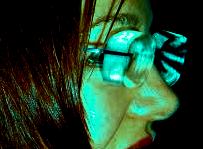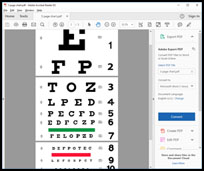A young woman at university in an Asian country contacted me recently about vision improvement. She wears a -10 prescription with an astigmatism correction as well, and got glasses at a very young age just like I did. She wants to believe she can improve her vision, but is surrounded by myopia — all the adults in her family wear strong glasses too. She had looked for vision improvement books in her home country, but only found some technical texts on optics, which were difficult for her to read since English is not her native language. She asked me what exercises she should be doing, and if there really was hope for her with such a high prescription.
My heart went out to this earnest young woman, who felt so like me at an earlier age. I knew I had to keep our communication simple and clear because of our language difference. Plus I really wanted to convey the basic principles of the Bates Method. Citing exercise after exercise without her understanding the purpose behind the exercise would be wasting the time of both of us. Plus I couldn’t help remembering my own experience when I started vision improvement. I treated the Long Swing like vigorous calesthenics, completely missing the point of the gentle easy movement.
The first explanatory email I wrote to her, before we had a Skype lesson where we could interact, focused on the dual principles of relaxation and awareness. I asked her questions like “Are you tensing your visual system before you even look in the distance, expecting seeing to be difficult?”. Or “Are you spending too much time at the computer, when maybe your eyes would love to go for a walk, breathe some fresh outdoor air, and look at the trees?”.
A few nights ago I called into a webinar hosted by famous vision teacher Greg Marsh, with whom I have worked a handful of times myself. Again, the focus (visual pun — ha!) was on relaxation — Greg is an excellent experienced gentle teacher. The next day I was thrilled to receive an email from a vision student I worked with last year. She had heard me on the webinar and wanted to re-connect. She started at -7 and said she is now happy in her -5 glasses, enjoying all she can see, and knows she will continue to improve. She also has had some astigmatism, and is regularly visualizing her corneas smooth and her eyeballs round.
In a week or so I’ll check back with the university student to see how she’s doing. She’s young and motivated, and right now is in a learning environment surrounded by other eager students. I have a lot of confidence she’ll start improving, learning how to see in a more relaxed healthy way. One thing she and I didn’t talk about much, since it was her first session, is the emotional component of vision restriction, though she did say she was afraid to take off her glasses when I taught her palming. I would like this woman to start learning there are other ways to deal with fear besides putting on strong glasses. The student who wrote to me after Greg’s webinar is well aware of this, and has used EFT or Emotional Freedom Technique to help reduce her anxiety, as I have myself.
So for those wanting to improve your vision, it’s not as mechanical as doing certain exercises while not changing any habits, or ignoring what you’re thinking or feeling. Especially for those with a strong prescription, this might be the hardest work you’ve ever done (yes, I was trying to relax for years which makes me laugh at myself now). This work may also be the most rewarding of anything you’ve done. Everyone deserves to have the clearest most peaceful sight they can with the eyes they have, and you are no exception. Notice how you’re using your eyes and your visual system, and see if you can let go of any strain you feel. Seeing well is a joy — let it be easy!

I wore strong glasses, then contact lenses, from age 5 into my 40s. While making many mistakes, eventually l learned how to improve the way I use my eyes and to see in a more relaxed, healthy manner. It is my pleasure to coach others to do the same. Visit me at https://NancyLNeff.com.


